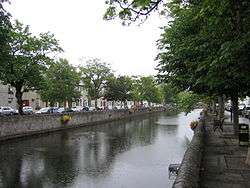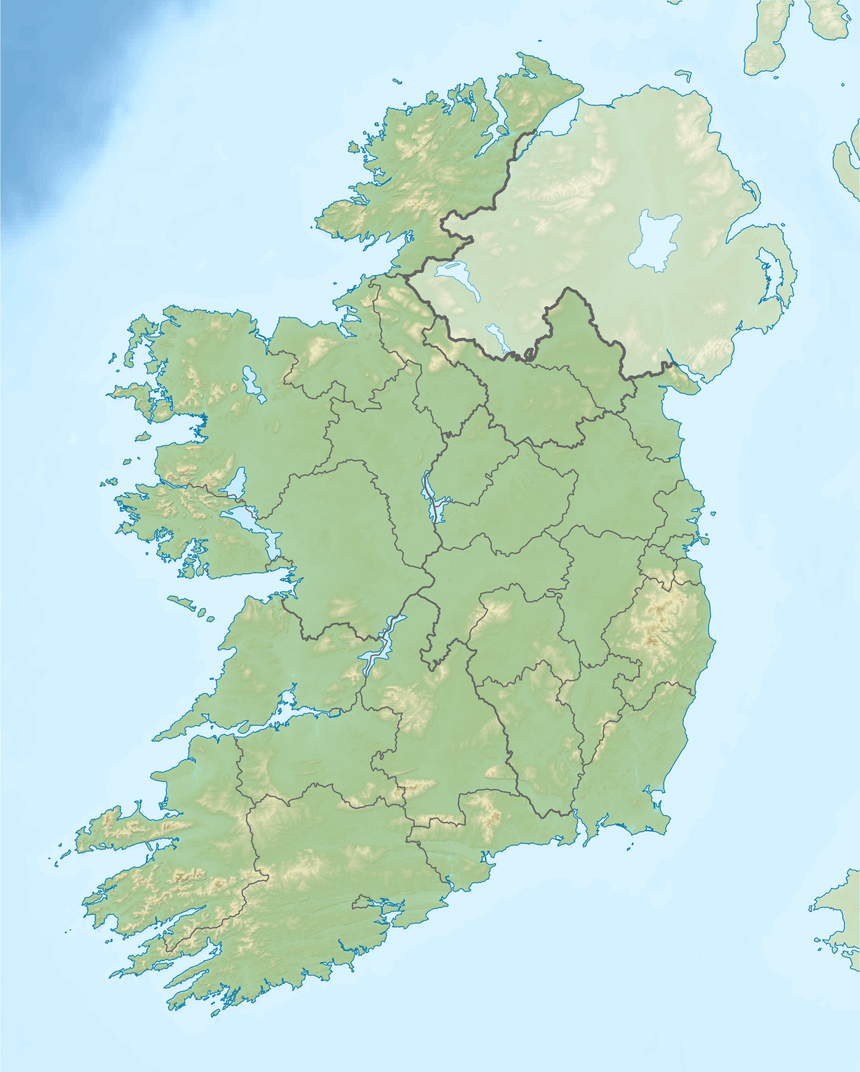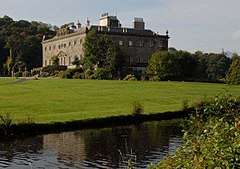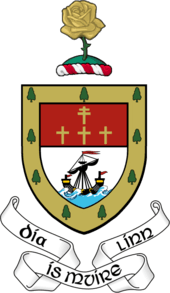Westport, County Mayo
Westport (Irish: Cathair na Mart, meaning "city of the beef cattle", historically anglicised as Cahernamart)[2] is a town in County Mayo in Ireland. It is at the south-east corner of Clew Bay, an inlet of the Atlantic Ocean on the west coast of Ireland. Westport is a popular tourist destination and scores highly for quality of life.[3] It won the Irish Tidy Towns Competition three times in 2001, 2006 and 2008.[4] In 2012 it won the Best Place to Live in Ireland competition run by The Irish Times.[5]
Westport Cathair na Mart | |
|---|---|
Town | |
 Mall along Carrowbeg River in Westport | |
 Coat of arms | |
 Westport Location in Ireland  Westport Westport (Europe) | |
| Coordinates: 53.8°N 9.5333°W | |
| Country | Ireland |
| Province | Connacht |
| County | |
| Elevation | 80 m (260 ft) |
| Population (2016)[1] | |
| • Urban | 6,198 |
| Time zone | UTC±0 (WET) |
| • Summer (DST) | UTC+1 (IST) |
| Eircode routing key | F28 |
| Telephone area code | +353(0)98 |
| Irish Grid Reference | M004841 |
| Website | www |
The design for the town was commissioned in the 1780s by the John Browne of the nearby stately home, Westport House, as a place for his workers and tenants to live. John Browne cleared the original village of Cahernamart, that had 700 inhabitants, to make way for his gardens at Westport House.[6]
The current town centre was originally designed by William Leeson in 1780, in the Georgian architectural style.[7] Its layout follows the medieval principles of urban design introduced by the Normans in the 13th century. A particular feature is the incorporation of the river into the composition, contained for two blocks by low stone walls producing, on each side of the river, tree lined promenades (The Mall) with several stone bridges over the river Carrow Beg.
The famous pilgrimage mountain of Croagh Patrick, known locally as "the Reek", lies some 10 km west of the town near the villages of Murrisk and Lecanvey. The mountain forms the backdrop to the town.
History

Westport originates and gets its name, in Irish, from a 16th-century castle - Cathair na Mart (meaning "the stone fort of the beeves" or "the city of the fairs") - and surrounding settlement, belonging to the powerful local seafaring Ó Máille clan, who controlled the Clew Bay area, then known as Umaill.
The original village of Cathair na Mart existed somewhere around what is now the front (east) lawn of Westport House. It had a high street, alleys down to the river and a population of around 700.[8] A small port also existed at the mouth of the Carrowbeg river. Roads lead from the village to the west (West Road), the south (Sandy Hill Road) and the east (Old Paddock Road). The town was moved to its present site in the 1780s by the Browne family of Westport House to make way for their gardens and was renamed Westport.[6]
Westport is designated as a heritage town and is unusual in Ireland in that it is one of only a few planned towns in the country.[9] A feature of his town plan is the tree-lined boulevard, the Mall, built on the Carrowbeg River.
James Wyatt finished Westport House, the stately home of the Marquess of Sligo and designed its dining room.[10] Westport House was originally built by Richard Cassels (also known as Richard Castle), the German architect, in the 1730s, near the site of the original Ó Máille Castle.[11]
Since the late 20th century, Westport has expanded with several new housing estates. Some of these include Springfield, the Carrowbeg Estate, Horkans Hill, Cedar Park, Fairways, Knockranny Village and Sharkey Hill.
Westport House

Designed by the famous architects Richard Cassels and James Wyatt in the 18th century, Westport House is situated in a parkland setting with a lake, terraces, gardens and views overlooking Clew Bay, the Atlantic Ocean, Achill, Clare Island and Ireland's Holy Mountain, Croagh Patrick.
In October 2015 it was revealed that the Westport House Estate was in the National Asset Management Agency (NAMA) for debts secured on the 380 acre estate, but not the house, for almost 10 million Euros.[12] In January 2017, it was announced that a local family had purchased the house and grounds.[13]
In 2007 the privately owned estate received a grant of 1.34 million Euros for repairs to Westport House, from the state funded Heritage Council.[14]
The previous owners, the Browne family, are direct descendants of wealthy slave plantation owners in Jamaica, Howe Peter Browne (2nd Marquess of Sligo) and his wife Lady Sligo (Hester Catherine De Burgh),[15] as well as the 16th-century pirate, Gráinne Ní Mháille, Queen of Umaill.
An exhibition at Westport House styles Howe Peter Browne as 'Champion of the Slaves',[16] a suggestion that one historian refers to as 'hyperbole', pointing out that "Browne benefited from slavery from the cradle to the grave and did not free his slaves until the institution of slavery was abolished by an act of parliament" and that Howe Peter Browne also claimed, and received, substantial compensation from the British government for the loss of his slaves.[15]
The original house was built by Colonel John Browne, a Jacobite, who was at the Siege of Limerick, and his wife Maude Bourke. Maude Bourke was Ní Mháille's great-great granddaughter. The house then did not have the lake or a dam, and the tide rose and fell against the walls.[17]
Demographics
| Year | Pop. | ±% |
|---|---|---|
| 1821 | 4,326 | — |
| 1831 | 4,448 | +2.8% |
| 1841 | 4,365 | −1.9% |
| 1851 | 4,114 | −5.8% |
| 1861 | 3,819 | −7.2% |
| 1871 | 4,417 | +15.7% |
| 1881 | 4,469 | +1.2% |
| 1891 | 4,070 | −8.9% |
| 1901 | 3,892 | −4.4% |
| 1911 | 3,674 | −5.6% |
| 1926 | 3,488 | −5.1% |
| 1936 | 3,409 | −2.3% |
| 1946 | 3,240 | −5.0% |
| 1951 | 3,104 | −4.2% |
| 1956 | 2,947 | −5.1% |
| 1961 | 2,882 | −2.2% |
| 1966 | 2,927 | +1.6% |
| 1971 | 3,023 | +3.3% |
| 1981 | 3,378 | +11.7% |
| 1986 | 3,456 | +2.3% |
| 1991 | 3,688 | +6.7% |
| 1996 | 4,520 | +22.6% |
| 2002 | 5,634 | +24.6% |
| 2006 | 5,475 | −2.8% |
| 2011 | 5,543 | +1.2% |
| 2016 | 6,198 | +11.8% |
| [1][18][19][20][21] | ||
Between the censuses of 2011 and 2016, the town showed a limited growth from 5,543 to 6,198 inhabitants.[22]
Culture
People from Westport town are traditionally known as Coveys.[23] Some decades ago the Covey dialect still existed and was unintelligible to outsiders. For example, the Covey word for a woman was a "doner".[24]
Matt Molloy of the Chieftains has a pub and music venue on Bridge Street.
Entertainment
Westport Town Hall Theatre was established in the early 1900s and renovated and refurbished in later years. The town hall hosts events, artists and musicians, local theatre groups and children's puppet shows.[25]
The hall overlooks the Octagon monument at the centre of Westport town. The venue has been an integral part of the town for decades where many local and surrounding townspeople visited for town dances, Irish dancing lessons, local craft fairs and other performing arts.
Events
Many festivals and events are held in and around Westport each year.[26]
- Westport Festival of Music and Performing Arts
- The Acoustic Yard Singer/Songwriters Festival, May
- Westport Horse & Pony Show, June
- Sea Angling Festival, June
- Croagh Patrick Pilgrimage, July
- Westport Arts Festival, October
- Westport Blue Grass Festival, June
- Westport Seafood Festival, October
- Westport Festival Of Chamber Music, September
- The Westport Shop n' Spraoi na Nollag, December
- The Saltwater Festival Westport[27]
Media
Newspaper
Westport has a regional newspaper based in the town, The Mayo News, founded in 1892 by William and Patrick Dorris.[28][29] Other newspapers available are the Mayo Advertiser, Western People and the Connaught Telegraph.
Radio
Local radio is delivered by Westport Radio 98.2 FM.[30]
Tourism
Westport is County Mayo's premier tourist destination,[31] visited by holiday makers from all over the world and Ireland.[32]
In 1842, the English novelist, William Makepeace Thackeray, visited Westport and wrote of the town:
"The most beautiful view I ever saw in the world. It forms an event in one's life to have seen that place so beautiful that is it, and so unlike other beauties that I know of. Were such beauties lying on English shores it would be a world's wonder perhaps, if it were on the Mediterranean or Baltic, English travellers would flock to it by hundreds, why not come and see it in Ireland!"[33]
Visitors visit Westport for the scenery, the pubs and restaurants in the town, blue flag beaches, and Croagh Patrick.[34] Its proximity to Connemara, Achill, Clew Bay and Croagh Patrick, and its hotels and guest houses, make it a base for holidaymakers to tour the region.
Westport House and its Pirate Adventure Park attracts families. Westport has an 18-hole golf course and nearby a 9-hole course.
In January 2008, Westport became Google Earth's first fully 3D town.[35][36]
International ties
Westport is twinned with Plougastel-Daoulas in Brittany, France and with Limavady, County Londonderry, Northern Ireland. The link with the latter has its roots in the 1980s and the official ratification and twinning ceremony took place in 2002.[37]
Since 1982, Westport also has a partnership with the town of Aror, Kenya, and the people of Westport have contributed to improving the infrastructure of Aror.[38][39]
Religion



There are four churches in the town: the Catholic Church, St Mary's; the Anglican church, Holy Trinity; the Evangelical church, Calvary Church Westport; the Elim Pentecostal Church, and Amazing Grace Church.[40] Historically, a Methodist church existed on the Mall and a Presbyterian church on Distillery Road.
Church records for the 19th century (Church of Ireland, Methodist, Roman Catholic, civil, gravestone inscriptions, etc.) and other historical records for the Westport area are held at the South Mayo Family Research Centre in Ballinrobe and the Clew Bay Heritage Centre at Westport Quay.
Education
Westport has two secondary schools, four primary schools and Westport College of Further Education, that opened in 2009.
The secondary schools are Rice College (528 pupils, all-boys)[41] and Sacred Heart School (over 500 pupils, all-girls).[42]
History
The educational facilities in Westport have for many years been associated with the Congregation of Christian Brothers. The first of these facilities was established in Castlebar Street in 1865 before transferring to the Newport road in 1962 where the former national school can still be seen today.[43]
In 1987 the secondary school Rice College was built on the Castlebar Road in order to cater for the increasing educational requirements.[43]
Transport
Rail
The town is the terminus of a 250 km Dublin-Westport/Galway railway line from Dublin Heuston in Dublin. This railway connects the town to Castlebar. Westport railway station opened on 28 January 1866.[44] The line originally ran through to Westport Quay station (opened on 1 January 1875 and closed in April 1977).[44] This line was lifted overnight in 1977 by Córas Iompair Éireann (CIÉ). In order to pacify local concern, the bulk of the trackbed of this extension was converted to a public walkway, still open today. There was also a branch to Achill Island branching off after the station, but this closed in 1937.
Bicycle
The Great Western Greenway is a greenway rail trail that follows the route of the former Midland Great Western Railway branch line to Achill, via Newport and Mulranny.[45]
Road
The N5 national primary route also connects the town to Castlebar, as well as connecting to the N4 near Longford that leads onward to Dublin. The other major road passing through Westport is the N59 national secondary route.
Air
The regional airport is Ireland West Airport Knock, 60 km (37 mi) away.
People
- George A. Birmingham, writer, rector of Holy Trinity Church, Westport. His play General John Regan caused a riot when staged in Westport.
- Cornelius Coughlan, Irish recipient of Victoria Cross, died and buried in Westport
- John MacBride, commemorated by a monument on the Mall. Born in Westport, he was executed in 1916 for his part in the Easter Rising. He was the father of Nobel peace laureate Sean MacBride.
- Joseph Maher, actor
- Conor O'Malley, footballer
- Michael Ring, politician
- Séamus Hughes, politician
- Lee Keegan, gaelic footballer.
The Quay

Westport has a small adjoining port, the quay, once busy but no longer used for commercial shipping, now a suburb notable for its many warehouse conversions. The quay is known for its restaurants and pubs. It also includes the training ground of Westport United. The Clew Bay Heritage Centre, a small museum celebrating the history of Westport and maritime history of Clew Bay, is open to the public here. In 1894, the harbour was the scene of the Clew Bay Drowning.
Sport
The Gaelic football club, Westport United soccer club and the rugby club have competed in county and national events. Westport, and the surrounding region, has been identified as a primary centre for adventure sports by Fáilte Ireland.[46] Every August it hosts the largest one-day adventure multi-sport race of its kind in the world – Gael Force West.[47][48] It is also home to horse riding, surfing, sea kayaking, wind surfing and sailing schools and other adventure sports.[49]
Angling
Westport is an angling centre providing sea fishing on Clew Bay and game and coarse fishing on nearby loughs and rivers.
Clew Bay itself is a sea angling centre hosting many sea fishing competitions each year and is known as a venue for common skate fishing in the country. It holds the Irish record for a 160 lb white skate. It is also considered one of the best venues for tope, huss and ray.[50][51]
Gaelic games
The Westport GAA club, CLG Chathair na Mart, have a history going back to the nineteenth century. Gaelic football is the main sport played within the club.
Golf
Westport Golf Club (championship) was in 2009 ranked 43rd out of the top 100 golf courses in Ireland by Golf Digest.[52] The Golfers Guide to Ireland 2016 voted Westport as the best Parkland in Connaught for the second time in the past three years.[53] It has hosted a number of tournaments, including the Ladies Home Internationals in 1989 and the Irish Amateur Close Championship on three occasions, the last time in 1997. It also hosted the Irish PGA Championship in 2002.
Soccer

Westport United football club was founded in 1911. Westport United won the FAI Junior Cup in 2005 in Kilkenny and play their home matches in the newly-developed United Park, which opened in September 2016. Westport United still uses the Sports Park for some underage games. The club colours are red and black. Westport also won the Connaught Cup in 1942, 1945, 1949, 1961, 1974, 1987 and 2012 along with numerous Mayo titles.
Rugby
Westport Rugby Club are located in Carrowholly, a few kilometres outside the town. League and Cawley cup champions in 2016 and junior cup champions in 2015.
Notes
- "Census 2016 Sapmap Area: Settlements Westport". Central Statistics Office (Ireland). Retrieved 10 July 2018.
- Placenames Database of Ireland (see archival records)
- LikePlace. "Ranking for this place". www.likeplace.ie. Retrieved 4 April 2018.
- "Three time winner of the SuperValu TidyTowns Competition, Westport, share some of their secrets for success". Irish Independent. 8 July 2016.
- "The Best Place to Live in Ireland: How Westport won". Conor Goodman. Irish Times. 30 June 2012.
- Antiquities of West Mayo", Christiaan Corlett, pp87 & Cathair na Mart No 26 2008, Journal of the Westport Historical Society, pp124
- William Leeson
- Peadar O'Flanagain "An Outline History of the Town of Westport" Cathair na Mart Journal
- "Westport, Co. Mayo, Ireland - Heritage Town". www.heritagetowns.com. Retrieved 4 April 2018.
- James Wyatt
- Richard Castle
- "Historic Westport House is facing a very modern threat". irishtimes.com. Retrieved 4 April 2018.
- "Westport House sold to local Mayo business family - Independent.ie". independent.ie. Retrieved 4 April 2018.
- "Archived copy" (PDF). Archived from the original (PDF) on 4 March 2016. Retrieved 7 October 2015.CS1 maint: archived copy as title (link)
- Hogan, Liam. "Opinion: Following the money – Irish slave owners in the time of abolition". thejournal.ie. Retrieved 4 April 2018.
- http://www.westporthouse.ie/westport-house-and-gardens/exhibitions/
- Westport House A Brief History published by Westport House 2008
- http://www.histpop.org
- "Archived copy". Archived from the original on 17 February 2012. Retrieved 24 August 2013.CS1 maint: archived copy as title (link)
- Lee, JJ (1981). "On the accuracy of the Pre-famine Irish censuses". In Goldstrom, J. M.; Clarkson, L. A. (eds.). Irish Population, Economy, and Society: Essays in Honour of the Late K. H. Connell. Oxford, England: Clarendon Press.
- Mokyr, Joel; O Grada, Cormac (November 1984). "New Developments in Irish Population History, 1700–1850". The Economic History Review. 37 (4): 473–488. doi:10.1111/j.1468-0289.1984.tb00344.x. hdl:10197/1406. Archived from the original on 4 December 2012.
- "Percentage population change in Ireland's cities and towns, 2011-2016. Westport". Census Statistics Office. Retrieved 9 October 2018.
- Schneider, Edgar W., ed. (1997). Englishes around the World volume 1. General studies, British Isles, North America. Studies in honour of Manfred Gorlach. Amsterdam: John Benjamins Publishing Company. p. 149. ISBN 90-272-4876-1.
- Boland, Rosita (30 June 2012). "Rain can't dampen the spirit of the people". The Irish Times. Retrieved 9 October 2018.
- "Westport Town Hall hosts family Christmas threatre". www.mayonews.ie. Retrieved 27 December 2019.
- "Archived copy". Archived from the original on 17 February 2013. Retrieved 28 September 2012.CS1 maint: archived copy as title (link)
- "Saltwater Festival Westport". Saltwater. Retrieved 27 December 2019.
- "The Mayo News Archive 1893 - Current". Irish Newspaper Archives. Retrieved 8 October 2018.
- Siggins, Lorna (19 November 2014). "European newspaper award for The Mayo News". The Irish Times. Retrieved 8 October 2018.
- "Westport Radio homepage".
Westport Radio 98.2 FM
- Davenport et al. Lonely Planet, Ireland, 7th ed., p. 425
- Essential Ireland, p, 150, AA Publishing 2007
- William Makepeace ThackerayThe Irish Sketch Book, 1845
- http://www.westportireland.com/town/westportfacts.aspx
- MyguideTravel Blog Google Earth and Tourism, MyguideTravel.com Blog 3D Westport
- Irish Independent, Western town boldly goes into virtual world
- "Archived copy". Archived from the original on 21 December 2009. Retrieved 26 January 2010.CS1 maint: archived copy as title (link)
- "What We Do". Westport/Aror Partnership. Retrieved 8 October 2018.
- MacNiff, Peter (20 March 1991). "Westport Twinned With Aror". RTÉ. Retrieved 8 October 2018.
- "Amazing Grace Fellowship, Westport". Amazing Grace Fellowship, Westport. Retrieved 4 April 2018.
- "Subject Inspection of Business Subjects Report. Rice College, Westport, County Mayo. Roll number: 64700O" (PDF). Department of Education and Skills. 8 March 2016. p. 3. Retrieved 8 October 2018.
- "Sacred Heart School". Department of Education and Skills. Retrieved 8 October 2018.
- Administrator. "Rice College, Westport". www.westportparish.ie. Retrieved 4 April 2018.
- "Westport and Westport Quay stations" (PDF). Railscot – Irish Railways. Retrieved 6 September 2007.
- "Home". Great Western Greenway. Retrieved 10 August 2011.
- Fáilte Ireland – West, Operational Plan 2008, Fáilte Ireland
- Team (9 April 2009). "Gaelforce West 2009 - RunIreland.com". runireland.com. Retrieved 4 April 2018.
- Multimedia, eCreo. "KILLARY GAELFORCE". www.gaelforceevents.com. Retrieved 4 April 2018.
- Multimedia, eCreo. "GAELFORCE WEST". www.gaelforceevents.com. Retrieved 4 April 2018.
- "Archived copy". Archived from the original on 22 June 2010. Retrieved 18 January 2010.CS1 maint: archived copy as title (link)
- "Archived copy". Archived from the original on 6 October 2008. Retrieved 18 January 2010.CS1 maint: archived copy as title (link)
- "Golf Digest Ireland Top 100 for 2009". irishgolfdesk.com. Retrieved 4 April 2018.
- "Westport Golf Club is an 18 hole championship golf course situated in Mayo in the west of Ireland –". www.westportgolfclub.ie. Retrieved 15 November 2017.
References
- Peadar O Flanagan, "An Outline History of the Town of Westport. Part 1. The origins and early development of the town 1750–80", in Cathar na Mart: The Journal of the Westport Historical Society; volume 1, part I, 1981; parts II-IV in volumes 2, 3 and 4, 1982–84.
- Kieran Clarke, "Clew Bay boating disaster", in Cathar na Mart; 6, 1986.
- Brendan Jeffars, Westport – an early Irish example of town planning, 1734–1950, Cahar na Mart; 8, 1988.
- Jarlath Duffy, "The port of Westport, 1800–1850", in Cathar na Mart; 15, pp. 1–14, 1995.
- Vincent Keane, "Westport and the Irish Volunteers. Part I:the early years, 1914–1916", Cathar na Mart; 22, pp. 84–88, 2002
External links
| Wikimedia Commons has media related to Westport, County Mayo. |
| Wikisource has the text of the 1911 Encyclopædia Britannica article Westport. |

- Westport Tourism
- Westport Town Council
- Westport GAA: CLG Chathair na Mart
